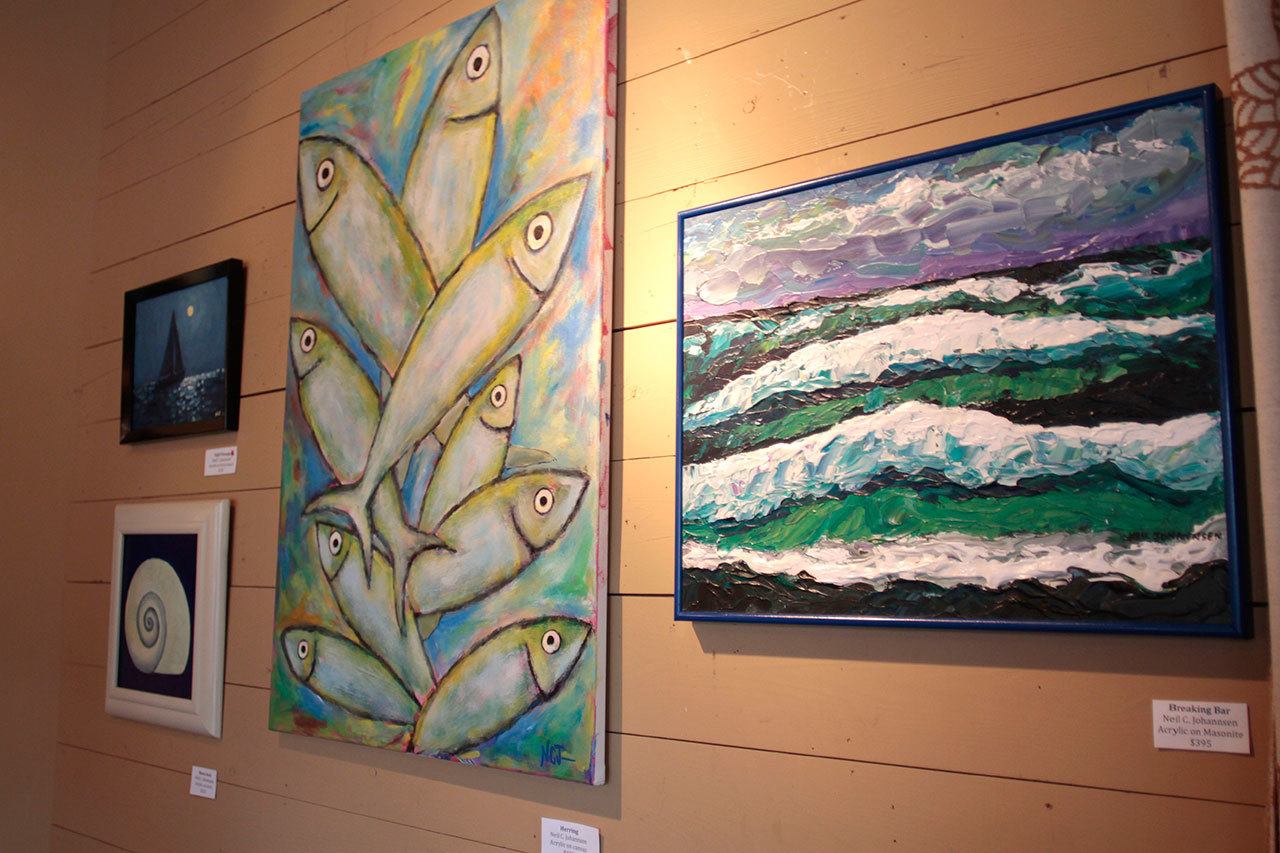Artistically, Neil Johannsen is no one-trick pony. He’s more like the whole rodeo.
Throughout his incredibly prolific and extensive body of work, varied aesthetics, subjects and mediums abound, making the 45-plus-piece exhibition currently on display at the Treehouse Café a lively tour through the man’s passions, experiences and influences depicted in such an array of styles that even some close friends thought at first he was sharing the space with another artist.
A retired director of Alaska State Parks (he even managed the mountain rescue team) and former chief of operations for California State Parks, it’s no wonder perhaps that Johannsen’s primary subjects have always been nature and wildlife.
But his works also include more abstract, symbolic imagery, the wildly popular Salish Sea Prayer Flags, on sale at Danger gallery and Bay Hay &Feed, and even a model of the famed Western Flyer now on permanent display at the National Steinbeck Center in California.
In 1940, John Steinbeck and his friend, marine biologist Ed Ricketts, chartered the 76-foot fishing boat Western Flyer in Monterey, California, and set out for the Gulf of California. They chronicled their trip in “Sea of Cortez,” published in 1941, a timeless blend of science, philosophy and research. Steinbeck later won the Nobel Prize, and Ricketts became famous as “Doc” in “Cannery Row.”
Johannsen’s Western Flyer model — a partnership between him and Charles Duerr, of the Northwest School of Wooden Boat Building — was unique for two reasons: it is the only one ever made of the historic vessel and it was constructed from wood salvaged from the original boat (now undergoing restoration in Port Townsend).
That project was a little lengthier than most, Johannsen said, as it was very intricate and required much time to reclaim the wood and research the boat, plus he was working with a partner.
Typically, his work flow is less a laconic stream than it is a raging whitewater rapid and he is very much a lone wolf. Once inspired, Johannsen said he doesn’t dedicate much time to conception. Subject chosen and materials considered, he tends to get to work rather quickly — and he moves on just as fast.
“When I finish a piece of art all I think about is the next one,” he said. “It doesn’t necessarily make me happy. I never felt like that was part of it.
“I get satisfaction. When I finish a piece of art I walk away from it. It doesn’t mean anything.”
Sometimes, though, it at least means a new challenge on the horizon. Johannsen, who said he creates about 30 pieces of art a year, is always trying new methods and techniques in his work.
“I’m driven,” he said. “I’m obsessed by it. I can’t not do it. It’s something that’s just really important to me to interpret nature through color, shape, shadow. I’ve built things out of wood. I sculpt. I even sculpt rock.”
Though he is now dedicating more time than ever before to his art, Johannsen had long been a seriously hard working creator, even when his professional life seemed at times overwhelming. Actually, especially then.
“It always has seemed almost like a paradox of forces,” he said. “My being involved in legislature, the political [process], the budget, the creation of parks, management of wild lands, whatever has been my life, but it was always my way to escape the pressure.
“I created 50 state parks in Alaska through my efforts,” Johannsen added. “To me, that was really important, but now, in an odd way looking back, it seems like my art is more important. I’ve moved away somewhat. I care deeply about the earth. I care deeply about protecting lands; saving the last of the best. But now my sort of physical and creative energy is going into art.”
His efforts to protect and to recreate nature often went hand-in-hand, the artist explained.
“I studied art a lot, but I have three degrees in the sciences so I mostly was into forestry, wildlife, wild land management, things like that,” he said. “But every day I worked as an artist.
“I’m obsessed by art,” he added. “The creativity of just the color and shape of nature has always kind of fascinated me with an interest in trying to portray it, to interpret it through my art.”
Johannsen’s work is on display in more than 50 public and private collections, and his exhibition at the Treehouse — a very well-received show at which numerous pieces were sold in the opening weekend — will remain up throughout the month of December. The Treehouse Café is located at 4569 Lynwood Center Road NE. Call 206-842-2814 or visit www.treehousebainbridge.com for hours and event info.
Visit www.neiljohannsen art.com to learn more about Johannsen, contact him directly and to see additional works.



